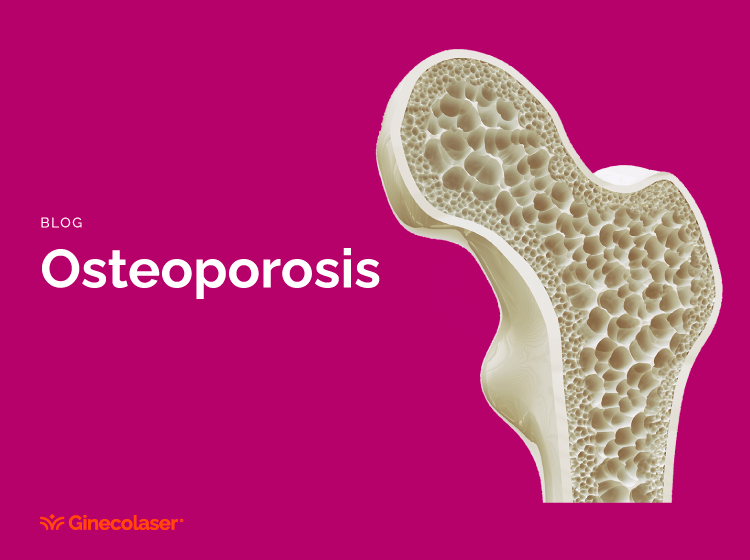Gyne Blog
Osteoporosis
Osteoporosis (OP) is a systemic skeletal disorder characterized by low bone mass and deterioration of the bone tissue microarchitecture, leading to increased bone fragility and a higher risk of fractures. Bone strength depends on both bone density and bon

OP is often called the “silent disease.” In Argentina, bone mineral density (BMD) studies show that among postmenopausal women, two out of four have osteopenia, one has OP, and only one has normal BMD. Osteoporotic fractures affect one in three women over the age of 50. The prevalence of OP and the incidence of fractures vary according to age and ethnicity.
It is important to remember that a prior fracture is the greatest risk factor for future fractures, regardless of BMD. Patients who have experienced fragility fractures have a significantly increased risk of new fractures.
Evaluation of patients with OP begins with a careful medical history, including assessment of risk factors such as: advanced age; Caucasian, Asian, or Hispanic ethnicity; low body mass index; family history of fractures in first-degree relatives; personal history of fractures and the time elapsed since them; premature ovarian failure; history of prolonged amenorrhea; low calcium intake; low vitamin D intake or limited sun exposure; eating disorders; hyperthyroidism; hyperparathyroidism; malabsorption syndromes; liver or kidney disease; rheumatoid arthritis; excess glucocorticoids; and use of medications such as anticonvulsants, heparin, or antiretrovirals.
The main radiographic features of generalized OP are increased radiolucency and cortical thinning. The former results from bone resorption and trabecular thinning.
Bone Mineral Densitometry (BMD)
Early diagnosis is key to appropriate intervention. Dual-energy X-ray absorptiometry (DXA) is the standard equipment used. There are three main reasons to perform it:
- Diagnosis of osteoporosis, as defined by the World Health Organization.
- To predict fracture risk.
- To monitor the natural progression of the disease or the therapeutic response to treatments specifically established for OP.
BMD by DXA
DXA BMD measurement is a simple, fast, painless procedure with low radiation exposure and low cost, which allows determination of the skeleton’s mineral density. BMD is not an all-or-nothing phenomenon; it is a continuous variable, and any cutoff for “normal” is influenced by the arbitrariness inherent in statistical calculations.
Indications for BMD testing include:
- Women aged 65 or older.
- Postmenopausal women under 65 with clinical risk factors for fractures.
- Women in the menopausal transition with fracture risk factors such as low body weight, previous fractures, or use of medications affecting bone mass.
- Men aged 70 or older.
- Men under 70 with clinical risk factors for fracture.
- Adults with fragility fractures.
- Adults with diseases or conditions associated with low bone mass or bone loss.
- Adults on medications associated with low bone mass or bone loss.
- Any condition considered for pharmacological therapy.
- Any treated condition, to monitor treatment effectiveness.
- Any untreated condition, where evidence of bone loss would indicate the need for treatment.
Women who have discontinued estrogen hormone therapy may be considered for BMD testing according to the indications listed above.
Non-Pharmacological Recommendations
- Maintain a balanced diet with adequate protein, calcium, and vitamin D intake, and avoid excessive salt.
- Perform weight-bearing exercises to reduce the risk of falls and improve bone formation and muscle strength.
- Stop smoking and reduce alcohol consumption, as numerous studies show negative effects on bone metabolism.
Calcium: Essential for reaching peak bone mass, and intake also affects the rate of bone loss.
Vitamin D: Its main biological effect is maintaining normal serum calcium levels. It can double the efficiency of intestinal calcium absorption.
Exercise: High-impact exercises help build bone, such as aerobic activities, dancing, jogging, stair climbing, or playing tennis. Low-impact weight-bearing exercises can also help and are safer for people who cannot perform high-impact activities.
Yoga and Pilates can improve strength, balance, and flexibility, but certain hyperflexion and hyperextension positions should be avoided as they may increase fracture risk.
Pharmacological Treatment
Osteoporosis is a multifactorial disease, and the therapeutic goal is to preserve skeletal structural integrity and prevent fragility fractures. Medications used to treat osteoporosis vary and should be prescribed by a professional based on personalized treatment needs.
Bioidentical Hormones
Hormone replacement therapy with bioidentical hormones can significantly improve symptoms related to impaired bone metabolism, including joint pain, bone issues, and other associated symptoms. Physical performance, body fat redistribution, muscle mass increase, and bone protection are also enhanced.
We look forward to seeing you at our clinics.
